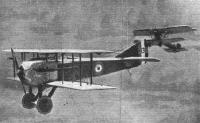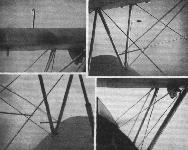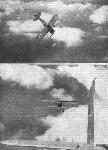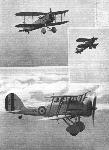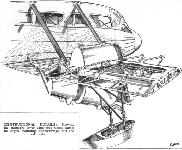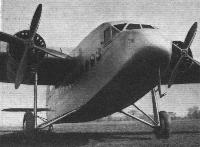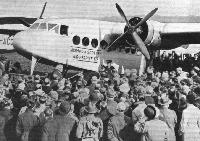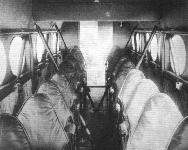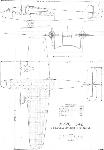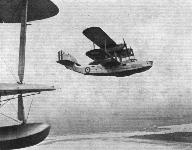Фотографии
-
NOT an armoured Junkers biplane creeping up behind a careless Spad, but some of the excellent models to be seen at the Science Museum.
Самолёты на фотографии: Junkers J.I / J 4 - Германия - 1917SPAD S.VII - Франция - 1916
-
ICE BOUND: In the upper left-hand picture is the petrol vent pipe, and on, the right the pitot head. The broken steadying tube is shown in the lower left-hand photograph, while on the right is the ice coated centre-section and its struts and wires.
Upper left: This remarkable picture was secured by Flight's chief photographer, who went "ice-hunting" in a Hawker Hart piloted by Flt. Lt. Bulman. It shows ice that has formed on the fuel tank vent pipe
Lower left: The ice-collecting expedition was continued until the steadying tube between two of the wires fractured, due to vibration caused by the heavy accretion on the wires.Самолёты на фотографии: Hawker Hart - Великобритания - 1928
-
A REHEARSAL: Messrs. Bulman and Sayer, Hawker's test pilots, putting two of the "Harts" (Bristol "Pegasus") ordered by Sweden through their paces. In the lower picture the two machines were climbing very steeply, the horizon being far above the upper edge of the photograph.
Самолёты на фотографии: Hawker Hart - Великобритания - 1928
-
Регистрационный номер: K3054 NOT Flt. Lt. Bulman making a "dead stick" landing at Brooklands in a "Hart", but one of the excellent models to be seen at the Science Museum.
Самолёты на фотографии: Hawker Hart - Великобритания - 1928
-
FOR BRITISH HOSPITALS: Mr. McEwan King and Mr. Leigh Mossley (dark suit) examining the latest three-seater "Hawk."
Самолёты на фотографии: Miles Hawk / M.2 - Великобритания - 1932
-
Регистрационный номер: S1595 ENSHRINED: The Vickers Supermarine S.6B and the Wright biplane are two of the great attractions at the Science Museum.
Самолёты на фотографии: Supermarine S.5 / S.6 - Великобритания - 1927Wright Flyer - США - 1903
-
A VARIED FLEET: Joyriders at Stag Lane on Sunday had the choice of a range of machines, from a "Moth" to an "Argosy." The "Moth" on the right of the picture brought Col. J. C. Fitzmaurice as a visitor during the afternoon.
Самолёты на фотографии: Armstrong Whitworth Argosy - Великобритания - 1926De Havilland Gipsy Moth / Moth X - Великобритания - 1928
-
FROM PLOUGH-SHARE TO SWORD: The Curtiss-Wright "Condor" Bomber, developed from the commercial transport "Condor."
Самолёты на фотографии: Curtiss Condor 18 - США - 1929
-
A NEW STYLE OF DECK FLYING: As previously reported in "Flight," Mr. de la Cierva recently alighted on, and afterwards took off from, the small Spanish seaplane transport, Dedalo, on his C.30P Autogiro. Here we see both phases of this demonstration.
Самолёты на фотографии: Cierva/Avro C.30A / Rota - Великобритания - 1932
-
Регистрационный номер: J9125 TRYING IT OUT: The Gloster "Gauntlet" shown in these photographs is fitted with the Bristol "Mercury VI" engine and a special Townend ring. THe pilot was Capt. Saint.
Самолёты на фотографии: Gloster Gauntlet - Великобритания - 1929
-
SERVICE MOUNTAINEERING: Part of the work covered by No. 30 Bomber Squadron, stationed at Mosul, in Northern Iraq, is to patrol the mountains of Kurdistan, on the borders of Iraq and Turkey and Persia. This is an extremely hazardous flight and is carried out weekly. The patrol lies over mountainous country where for more than an hour engine failure or any other cause of a forced landing would mean a certain crash. This picture was taken during an actual reconnaissance patrol made by three "Wapitis" of the No. 30 Bomber Squadron over the mountains of Kurdistan, in Northern Iraq.
Самолёты на фотографии: Westland Wapiti - Великобритания - 1927
-
VOUGHT CORSAIRS IN FLIGHT
Самолёты на фотографии: Vought O2U/O3U/V-65/V-93 Corsair - США - 1926
-
THE VOUGHT "CORSAIR" V.90: Note the "cabin" top over the cockpits, This feature is to be found in many modern American two-seaters.
V-90 series came in Standard (shown here) or Super models the latter with N.A.C.A. cowling, c.p. airscrew, and exhaust collector ring. V-93 (Hornet SD) landplane did 184 m.p.h. at 6 000 ft. in standard form, or 191.5 m.p.h. in Super form.Самолёты на фотографии: Vought O2U/O3U/V-65/V-93 Corsair - США - 1926
-
Vought "Corsair" V-90
Самолёты на фотографии: Vought O2U/O3U/V-65/V-93 Corsair - США - 1926
-
LIGHTER CONSTRUCTION: These two views show the Saro "Cloud," for which a Monospar wing has been built. As can be seen, the wing is heavily tapered, and the result should be an increase in performance.
Самолёты на фотографии: Saunders-Roe Cloud / A.19 - Великобритания - 1930
-
Самолёты на фотографии: De Havilland Dragon Rapide / Dominie / D.H.89 - Великобритания - 1934
-
SPEEDY AND ROOMY: View of the "Dragon Six" taken recently at Stag Lane.
Самолёты на фотографии: De Havilland Dragon Rapide / Dominie / D.H.89 - Великобритания - 1934
-
HEAD ON: The manner in which low profile drag has been achieved to a great extent is shown in this photograph.
Самолёты на фотографии: De Havilland Dragon Rapide / Dominie / D.H.89 - Великобритания - 1934
-
CONSTRUCTIONAL DETAILS: Showing the starboard lower wing root which carries the engine mounting, undercarriage, fuel and oil tanks.
Самолёты на фотографии: De Havilland Dragon Rapide / Dominie / D.H.89 - Великобритания - 1934
-
WING ATTACHMENTS: Fittings and details of the bottom longeron showing the Elektron fairing which carries the fabric over the corner of the fuselage.
Самолёты на фотографии: De Havilland Dragon Rapide / Dominie / D.H.89 - Великобритания - 1934
-
WING DETAILS: On the left is the arrangement of a spar joint, also showing the attachment of one of the steel tube drag struts. On the right are rib details and the leading edge of the wing.
Самолёты на фотографии: De Havilland Dragon Rapide / Dominie / D.H.89 - Великобритания - 1934
-
D.H. "Dragon Six" 2-200 hp. "Gipsy Six" Engines
Самолёты на фотографии: De Havilland Dragon Rapide / Dominie / D.H.89 - Великобритания - 1934
-
THROUGH THE HOOP: Mr. Tyson diving a "Tiger Moth" underneath a cord preparatory to looping up over it.
Самолёты на фотографии: De Havilland Tiger Moth / D.H.82 - Великобритания - 1931
-
Same pilot, different aeroplane. Tyson in characteristic attitude in a Tiger Moth at Dagenham on Saturday, April 14, 1934.
Самолёты на фотографии: De Havilland Tiger Moth / D.H.82 - Великобритания - 1931
-
Самолёты на фотографии: Percival Gull - Великобритания - 1932
-
A MODERN INTERIOR: Two wide doors are provided for passengers in the 1934 model "Gull." A third door gives easy access to the luggage locker.
Самолёты на фотографии: Percival Gull - Великобритания - 1932
-
EN NEGLIGE: Showing the improved wing folding arrangements, part of the fuel system and the contents of one of the spats of the 1934 model Percival "Gull."
Самолёты на фотографии: Percival Gull - Великобритания - 1932
-
Регистрационный номер: G-ACPA SITTING PRETTY: The 1934 Percival "Gull." Note, in this view, the neat installation of the tail wheel.
Самолёты на фотографии: Percival Gull - Великобритания - 1932
-
Регистрационный номер: G-ACCV A view showing some of the machines which visited the Club Sunday afternoon, the extreme left the Mollisons' "Dragon."
Самолёты на фотографии: De Havilland Dragon / D.H.84 - Великобритания - 1932
-
Регистрационный номер: G-ACMC, G-ACMO, VH-ABK AERIAL ACTIVITY AT JERSEY: Six D.H. "Dragons," of Jersey Airways, Ltd., on the sea-shore "aerodrome" at St. Helier during the Easter rush.
Самолёты на фотографии: De Havilland Dragon / D.H.84 - Великобритания - 1932
-
Регистрационный номер: J-BAXA BRITISH AIR TRANSPORT IN JAPAN: Four D.H. "Puss Moths" owned and operated by the "Osaka Asahi," the Japanese newspaper.
Самолёты на фотографии: De Havilland Puss Moth / D.H.80 - Великобритания - 1929
-
Регистрационный номер: G-ACFV [4], VH-UXD [4] Seen from this angle while flying over Woodford, the Avro 642 is particularly pleasing.
Самолёты на фотографии: Avro Type 642 - Великобритания - 1933
-
"Head on" the Avro 642 displays the clean lines which account for its fine performance.
Самолёты на фотографии: Avro Type 642 - Великобритания - 1933
-
Since we published a photograph some time ago, the nose of the 642 has been re-designed, giving it a cleaner entry and enhanced performance.
Самолёты на фотографии: Avro Type 642 - Великобритания - 1933
-
THE BAPTISM: The Prime Minister naming the Avro 642 of Midland Be Scottish Air Ferries, Ltd., the "Marchioness of Londonderry."
Самолёты на фотографии: Avro Type 642 - Великобритания - 1933
-
Регистрационный номер: G-ACFV [4], VH-UXD [4] This side view shows the ample window area provided for the passenger cabin which makes the inside particularly light and airy.
Самолёты на фотографии: Avro Type 642 - Великобритания - 1933
-
AVRO'S WOODFORD STAFF: A. V. Roe & Co., Ltd., have their own aerodrome at Woodford, near Manchester, and there they test and service their machines. The large number of aircraft they are now turning out necessitates a staff of considerable size. Here they are, in front of the new Avro 642 sixteen-seater, with Mr. F. B. Tomkins (right), one of the firm's test pilots, who is in charge at the aerodrome.
Самолёты на фотографии: Avro Type 642 - Великобритания - 1933
-
Регистрационный номер: G-ACFV [4], VH-UXD [4] Despite its loading and performance the Avro 642 has quite a low landing speed.
Самолёты на фотографии: Avro Type 642 - Великобритания - 1933
-
Регистрационный номер: G-ACFV [4], VH-UXD [4] A three-quarter view showing the balanced elevators and generator mounting on the top of the fuselage.
Самолёты на фотографии: Avro Type 642 - Великобритания - 1933
-
Inside, Mr. Sword has had this machine upholstered in red and brown, which gives a pleasing, cheerful effect.
Самолёты на фотографии: Avro Type 642 - Великобритания - 1933
-
Avro 642 2 Siddeley "Jaguar" VI.D Engines
Самолёты на фотографии: Avro Type 642 - Великобритания - 1933
-
Регистрационный номер: G-ACNY FOR TRANSPORTING THE S.O.S.: As we have already recorded, Lord Londonderry, the Secretary of State for Air, learnt to fly and obtained his "A" licence at Heston. He has now purchased through Henlys, Ltd., this Avro "Cadet" (Siddeley "Genet") for his own use.
Самолёты на фотографии: Avro Club Cadet / Type 638/639/640 - Великобритания - 1933
-
Регистрационный номер: G-ACLY FOR FUEL AND OIL SERVICE: Mr. J . Taylor, a pilot and a member of the aviation staff of Shell-Mex & B.P., Ltd., standing beside one of the company's aeroplanes, a D.H. "Leopard Moth" ("Gipsy Major").
Самолёты на фотографии: De Havilland Leopard Moth / D.H.85 - Великобритания - 1933
-
A FLYING AMBASSADOR: His Excellency Sir Francis Humphrys, the British Ambassador at Baghdad, is a flying ambassador, for he owns and flies his own machine. The latter, a D.H. "Leopard Moth," was flown out to him from England recently, and here we see him starting up the engine prior to a 200-mile flight to Mosul, in Northern Iraq, with his son and daughter - who may be seen in the background on the right.
Самолёты на фотографии: De Havilland Leopard Moth / D.H.85 - Великобритания - 1933
-
Регистрационный номер: G-ACKP RESERVED FOR THE AVIATOR: Cloud such as these are often to be seen even in mid-winter, but usually it is necessary, as in the case of this de Havilland "Leopard Moth," to go to a height of more than 9,000 ft. to get into the sunshine.
Самолёты на фотографии: De Havilland Leopard Moth / D.H.85 - Великобритания - 1933
-
THE ALTITUDE RECORD: Renato Donati, who has just captured the world's altitude record for Italy.
Самолёты на фотографии: Breda Ba.33 / Ba.39 / Ba.42 - Италия - 1931
-
Регистрационный номер: VT-AEG, DG454, G-ABTM COMMERCIAL AND PRIVATE ENTERPRISE: Imperial Airways Armstrong-Whitworth airliner Aurora (pilot, Capt. Egglesfield) alighting on the Kuala Lumpur Flying Club's aerodrome, with the homeward mail, on March 11. This aerodrome is now one of the halting places on the Imperial air route.
Самолёты на фотографии: Armstrong Whitworth Atalanta / A.W.15 - Великобритания - 1932
-
MONOSPARS IN BRAZIL: Two Monospar ST.4 machines operated by Viacao Aerea Sao Paulo (VASP) of Brazil.
Самолёты на фотографии: General Aircraft Monospar ST-4 - ST-12 - Великобритания - 1932
-
BY THE VENTNOR LANDSLIP: Five Supermarine "Southamptons" IIs of No. 201 (Flying Boat) Squadron based at Calshot in excellent formation following the steep southern coast of the Isle of Wight, seen late in 1933.
Самолёты на фотографии: Supermarine Southampton / Solent - Великобритания - 1925
-
Самолёты на фотографии: Supermarine Southampton / Solent - Великобритания - 1925
-
LANDING IN FORMATION: No. 201 (F.B.) Squadron displays its smartness in alighting.
Самолёты на фотографии: Supermarine Southampton / Solent - Великобритания - 1925
-
Регистрационный номер: S1648 [2] "FORMATING": The Vickers Supermarine "Scapa" photographed from a "Southampton."
Самолёты на фотографии: Supermarine Scapa - Великобритания - 1932Supermarine Southampton / Solent - Великобритания - 1925
-
NO. 201 (FLYING BOAT) SQUADRON: A group of officers and airmen under the wings of a Supermarine "Southampton" in one of the sheds at Calshot.
Самолёты на фотографии: Supermarine Southampton / Solent - Великобритания - 1925
-
Самолёты на фотографии: Supermarine Southampton / Solent - Великобритания - 1925
-
OVER THE BEAULIEU RIVER: Airmen alone can see the number of S loops made by this very tidal river as it makes its way through the New Forest.
Самолёты на фотографии: Supermarine Southampton / Solent - Великобритания - 1925
-
The head-on view, more particularly when the landing gear is retracted, shows how clean it is possible to get a machine of this nature.
Самолёты на фотографии: Comper Streak / Kite - Великобритания - 1934
-
RACY LOOKING: The two views of the new Comper "Streak" bring out the racy lines of this machine.
Самолёты на фотографии: Comper Streak / Kite - Великобритания - 1934
-
ROOT DETAILS: The finished "Streak" will in all probability be heavily filleted at the wing roots. Near the leading edge can be seen the exhaust for the cooling air which is led through the oil tank. The windows in the sides of the pilot's cockpit should also be noted.
Самолёты на фотографии: Comper Streak / Kite - Великобритания - 1934
-
RETRACTABLE: On the right is a perspective sketch showing the general details of one side of the retractable landing gear, and on the left is the mechanism whereby the locking pins are withdrawn preparatory to raising the landing gear.
Самолёты на фотографии: Comper Streak / Kite - Великобритания - 1934
-
FUSELAGE DETAILS: In these sketches our artist brings out very clearly the constructional details of the central portion of the fuselage. On the right, the lever which raises and lowers the undercarriage.
Самолёты на фотографии: Comper Streak / Kite - Великобритания - 1934
-
Comper "Streak" Gipsy "Major" Engine
Самолёты на фотографии: Comper Streak / Kite - Великобритания - 1934
-
One of the tightly packed queues of people waiting for joyrides in an Avro ("Lynx").
Самолёты на фотографии: Avro Avro 504N - Великобритания - 1920
-
A SPARTAN IN SWEDEN: This Spartan ("Hermes II") is used by Wideroe's Flyveselskap of Oslo for flights up to the mountains. It is shown fitted with skis, and Lt. A. Wideroe is seen attending to the skis for his own undercarriage.
Самолёты на фотографии: Simmonds Spartan - Великобритания - 1928
-
Регистрационный номер: G-ABBK FROM BARNSTAPLE: Some members of the recently-formed Barnstaple and North Devon Flying Club. Included in the group are R. T. Boyd, founder of the Club, and T. W. J. Nash, A.F.M., pilot.
Самолёты на фотографии: De Havilland Gipsy Moth / Moth X - Великобритания - 1928
-
FROM ABOVE: The "Scapa" has a normal biplane wing structure, with struts and wires reduced to a minimum. The engines are Rolls-Royce "Kestrels."
Самолёты на фотографии: Supermarine Scapa - Великобритания - 1932
-
Регистрационный номер: S1648 [2] ASHORE: The "Scapa" on its launching trolley The machine is not an amphibian, and the trolley is, of course, left behind when the flying boat is afloat.
Самолёты на фотографии: Supermarine Scapa - Великобритания - 1932
-
Регистрационный номер: G-ACJJ [6] WELL AWAY: The Short "Scylla" taking off at a weight of 30,000 lb. The take-off time was 11 sec.
Самолёты на фотографии: Short Scylla / L.17 - Великобритания - 1934
-
Регистрационный номер: G-ACJJ [6] In the Scylla the superstructure of the Scipio was applied to a landplane fuselage. The engines are four Jupiters.
Самолёты на фотографии: Short Scylla / L.17 - Великобритания - 1934
-
Регистрационный номер: G-ACJJ [6] NEAR THE MEDWAY: The Short "Scylla" looks at her home.
Самолёты на фотографии: Short Scylla / L.17 - Великобритания - 1934
-
Регистрационный номер: G-ACJJ [6] 30,000 LB. IN THE AIR: The Short "Scylla" (four Bristol "Jupiter") making a test flight with nearly full load, piloted by Mr. Lankester Parker. This and the other aerial views of the machine were secured from a "Fox Moth" belonging to Gravesend Aviation, Ltd., and piloted by Mr. P. H. Smith.
Самолёты на фотографии: Short Scylla / L.17 - Великобритания - 1934
-
Регистрационный номер: G-ACJJ [6] TOWERING: With tail on the ground, the height of the "Scylla" is just under 30 ft. The engines are Bristol "Jupiters," series XF BM.
Самолёты на фотографии: Short Scylla / L.17 - Великобритания - 1934
-
Регистрационный номер: G-ACJJ [6] COMFORT: A view in the rear cabin of the "Scylla." The mean width of the cabin is just under 11 ft.
Самолёты на фотографии: Short Scylla / L.17 - Великобритания - 1934
-
WIRELESS ON THE "SCYLLA": Marconi medium-wave telegraph-telephone set Type A.D. 41A/42A to be fitted in the new Imperial Airways "Scylla" class aircraft.
Самолёты на фотографии: Short Scylla / L.17 - Великобритания - 1934
-
WING DETAILS: Duralumin spars and ribs, with steel fittings, are used in the Short "Scylla."
Самолёты на фотографии: Short Scylla / L.17 - Великобритания - 1934
-
WING ATTACHMENTS: These two sketches show the details of the fittings by means of which rear and front lower spars are secured to the top of the fuselage. The front spar fitting also takes the undercarriage leg.
Самолёты на фотографии: Short Scylla / L.17 - Великобритания - 1934
-
NO WASTE OF SPACE: By utilising a large proportion of the fuselage the cabins are roomy and with plenty of leg room.
Самолёты на фотографии: Short Scylla / L.17 - Великобритания - 1934
-
THE TIP OF A MAIN SPAR: Instead of the corrugated section the tip becomes a plain box section.
Самолёты на фотографии: Short Scylla / L.17 - Великобритания - 1934
-
Short "Scylla" 4 Bristol "Jupiter" X F.B.M. Engines
Самолёты на фотографии: Short Scylla / L.17 - Великобритания - 1934
-
"- SOMETHING DONE": Miss Joan Meakin in her "Rhonbussard" glider.
Самолёты на фотографии: Schleicher Rhonbussard - Германия - 1933
-
COMING IN: Miss Meakin landing at Heston after her flight from Lympne.
Самолёты на фотографии: Schleicher Rhonbussard - Германия - 1933
-
Регистрационный номер: F-AMVB The Caudron low-wing monoplane (150 h.p. Renault "Bengali") which has established a new record for two-seater light planes weighing less than 500 kg.
Самолёты на фотографии: Caudron C.430 Rafale - Франция - 1934
Статьи
- Flight
